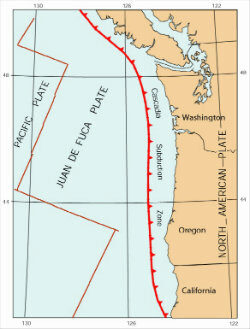A megathrust earthquake fault in our backyard

The Cascadia Subduction Zone is a roughly north-south oriented megathrust earthquake fault that exists offshore from Cape Mendocino, California, to Vancouver Island, British Columbia, and is roughly 700 miles [1,130 km] long. It is capable of generating a "great earthquake" of magnitude 9.0, which is comparable to some of the most powerful and violent earthquakes observed anywhere on Earth. Examples of recent subduction zone earthquakes include the 2011 Tohoku, Japan, earthquake, a magnitude 9.0, and the Northern Sumatra earthquake of 2004, a magnitude 9.1. Currently, the Cascadia Subduction Zone is locked by friction and slowly building strain. When it ruptures, a very powerful and damaging earthquake and subsequent tsunami will be generated.
The last Cascadia subduction zone earthquake
The Cascadia Subduction Zone has a history of producing very powerful earthquakes. The last known earthquake occurred on January 26, 1700, at around 9:30 pm. The date is accurately known because the tsunami it generated was recorded by coastal residents in Japan. Scientific research suggests this was a magnitude 9.0 earthquake. For more information about how scientists identified the 1700 earthquake, read The Orphan Tsunami(Link is external) published by the U.S. Geological Survey (USGS).
Our risk
The Cascadia Subduction Zone is capable of generating a devastating earthquake at any time. On average, the zone produces a 9.0 or larger magnitude earthquake about every 400 to 600 years, although intervals have been as low as 200 years and as high as 1,000 years. The southern end of the zone has historically been more active than the northern. A study published online(Link is external) by the USGS indicates the southern portion of the zone has earthquakes on average every 240 years and has a 40% chance of a major earthquake (8.0 to 8.5) in the next 50 years. According to the Oregon Resilience Plan(Link is external), there is a 7-15% chance of a magnitude 9.0 earthquake within the next 50 years. Watch this great video(Link is external) on the Cascadia Subduction Zone earthquake threat produced by the Oregon Department of Geology and Mineral Industries.
Impacts of a Cascadia subduction zone earthquake
There are three reasons why a Cascadia Subduction Zone earthquake will cause widespread damage – the size of the area affected by ground shaking, the duration of shaking, and the type of shaking. In a subduction zone earthquake, areas from Northern California to British Columbia will experience very intense ground shaking whereas shaking during a local earthquake will be confined to areas around the epicenter. During a subduction zone earthquake, intense ground shaking will likely occur for four to six minutes whereas a local earthquake is likely to produce shaking lasting 30 seconds or less. Lastly, a subduction zone earthquake will produce a type of shaking (low frequency) to which "long and tall" structures are more vulnerable.
According to the Oregon Resilience Plan, damages from a Cascadia Subduction Zone earthquake in the Pacific Northwest will be unprecedented. Total economic losses in Oregon are projected to exceed $32 billion (close to one-fifth of Oregon's gross state product). Fatalities in Oregon may range from 650 to 5,000, and over 27,000 may be displaced from their homes. Completely destroyed buildings could reach 24,000 with another 85,000 sustaining extensive damage and requiring months to years to repair. Essential services in Washington County will likely be offline for extended periods of time – water and sewer systems for one month to one year, electricity for one to three months, police and fire stations for two to four months, top-priority highways from six to twelve months, and healthcare facilities for 18 months. Additionally, major disruptions to fuel supply and telecommunications are expected.
